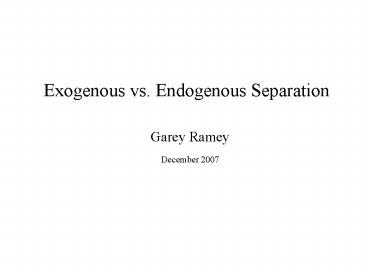Exogenous vs' Endogenous Separation - PowerPoint PPT Presentation
1 / 33
Title:
Exogenous vs' Endogenous Separation
Description:
Job match. Exogenous separation: Summary: Summary: Constant separation rate ... Models with exogenous separation rates cannot match key features of the data ... – PowerPoint PPT presentation
Number of Views:31
Avg rating:3.0/5.0
Title: Exogenous vs' Endogenous Separation
1
Exogenous vs. Endogenous Separation Garey
Ramey December 2007
2
Approaches to modeling separation
margin Exogenous and constant Costain Reiter
(2006), Fujita Ramey (2007), Hagedorn
Manovskii (2008), Hall (2005), Hall and Milgrom
(2008), Hornstein, et al (2005), Mortensen
Nagypal (2007), Shimer (2005), Yashiv (2006),
others Exogenous and time-varying Mortensen
(2005), Mortensen Nagypal (2007), Shimer
(2005) Endogenous Cole and Rogerson (1999),
Fujita (2003,2004), Mortensen Pissarides
(1994), Pissarides (2007), others OTJ search
Mortensen (1994,2005), Krause Lubik (2006),
Pissarides (1994), Nagypal (2005a,b), Tasci
(2006), others
3
- Empirical strategy
- Consider discrete-time version of standard
Pissarides (2000) specification - Calibrate at weekly frequency using standard
parameter values - Solve for dynamic stochastic equilibria with
persistent idiosyncratic shocks - Evaluate model using a wide range of empirical
measures
4
Preview of results Time-varying separation rates
raise unemployment volatility Exogenous
separation rate unrealistic volatility and
comovement of separation rate and worker
flows Endogenous separation rate without OTJ
search unrealistic Beveridge curve
correlation All four specifications
insufficient volatility of job finding rate,
vacancies and market tightness OTJ search with
Hagedorn-Manovskii parameters performs well
along all dimensions
5
Matching market
- matching function
- market tightness
6
Matching market
- matching function
- market tightness
7
Matching market
- matching function
- market tightness
Free entry -
8
Job match
9
Job match
Exogenous separation
10
Job match
Exogenous separation
11
Summary
12
Summary
Constant separation rate -
AR(1) separation rate -
13
Endogenous separation
14
Endogenous separation
lognormal, parameters
15
Endogenous separation
lognormal, parameters
16
OTJ search
17
OTJ search
18
OTJ search
determined as above
19
Calibration
- Mortensen Nagypal (2007)
- survey evidence
- 3 mo. mean waiting time
- mean match productivity 1
- Fujita Ramey (2007)
Remaining parameters
- Fujita Ramey (2006)
20
Solution method
21
Solution method
22
Endogenous separation
23
Figure 1. Unemployment and worker transition
rates
24
Figure 2. Worker flows
25
Figure 3. Vacancies and market tightness
26
Figure 4. Contemporaneous correlations
27
Figure 7. Cross elasticities with productivity
Vacancies and market tightness
28
Figure 9. Unemployment and worker transition
rates
29
Figure 10. Worker flows
30
Figure 11. Vacancies and market tightness
31
Figure 12. Contemporaneous correlations
32
Broad conclusions
Models with exogenous separation rates cannot
match key features of the data
OTJ search model with HM calibration does a good
job along nearly all dimensions considered
33
Broad conclusions
Models with exogenous separation rates cannot
match key features of the data
OTJ search model with HM calibration does a good
job along nearly all dimensions considered
Outstanding issues
Reasonableness of HM parameter choices wage
rigidity needed?
Failure to generate realistic dynamic
interrelationships creation costs needed?































